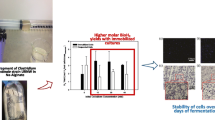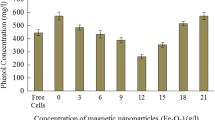Abstract
In order to supplement the need for alternative energy resources within the near future, enhancing the production of biohydrogen with immobilized Clostridium beijerinckii NCIMB8052 was investigated. Magnetite nanoparticles were functionalized, with chitosan and alginic acid polyelectrolytes using a layer-by-layer method, to promote bacterial attachment. Cultivating C. beijerinckii with these nanoparticles resulted in a shorter lag growth phase and increased total biohydrogen production within 100-ml, 250-ml and 3.6-L reactors compared with freely suspended organisms. The greatest hydrogen yield was obtained in the 250-ml reactor with a value of 2.1 ± 0.7 mol H2/mol glucose, corresponding to substrate conversion and energy conversion efficiencies of 52 ± 18 and 10 ± 3 %, respectively. The hydrogen yields obtained using the immobilized bacteria are comparable to values found in literature. However, to make this process viable, further improvements are required to increase the substrate and energy conversion efficiencies.






Similar content being viewed by others

References
Bartacek J, Zabranska J, Lens PNL (2007) Developments and constraints in fermentative hydrogen production. Biofuels Bioprod Biorefin 1(3):201–214. doi:10.1002/bbb.17
Brentner LB, Peccia J, Zimmerman JB (2010) Challenges in developing biohydrogen as a sustainable energy source: implications for a research agenda. Environ Sci Technol 44(7):2243–2254. doi:10.1021/es9030613
Conti J, Holtberg P (2011) International Energy Outlook U.S.E.I. Administration, Washington, DC.DOE/EIA-0484(2011). http://large.stanford.edu/courses/2012/ph241/miller1/docs/0484-2011.pdf. Accessed September 2011
Cranston GR, Hammond GP (2010) North and south: regional footprints on the transition pathway towards a low carbon, global economy. Appl Energ 87(9):2945–2951. doi:10.1016/j.apenergy.2009.08.015
Cullen JM, Allwood JM (2010) The efficient use of energy: tracing the global flow of energy from fuel to service. Energ Policy 38:75–81. doi:10.1016/j.enpol.2009.08.054
Decher G (1997) Fuzzy nanoassemblies: toward layered polymeric multicomposites. Science 277(5330):1232–1237. doi:10.1126/science.277.5330.1232
Ghosh D, Hallenbeck PC (2014) Metabolic engineering: key for improving biological hydrogen production. In: Lu X (ed) Biofuels from microbes to molecules, 1st edn. Horizon Scientific Press, United Kingdom, pp 1–46
Ghosh D, Pramanik P (2010) Low molecular weight biodegradable polymer based nanoparticles as potential delivery systems for therapeutics: the way forward? Int J Pharm Sci Drug Res 2(1):31–34
Ghosh D, Pramanik A, Sikdar N, Ghosh SK, Pramanik P (2010) Amelioration studies on optimization of low molecular weight chitosan nanoparticle preparation, characterization with potassium per sulphate and silver nitrate combined action with aid of drug delivery to tetracycline resistant bacteria. Int J Pharm Sci Drug Res 2(4):247–253
Ghosh D, Pramanik A, Sikdar N, Pramanik P (2011) Synthesis of low molecular weight alginic acid nanoparticles through persulfate treatment as effective drug delivery system to manage drug resistant bacteria. Biotechnol Bioprocess Eng 16(2):383–392. doi:10.1007/s12257-010-0099-7
Hallenbeck PC, Ghosh D (2009) Fermentative hydrogen production: the way forward? Trends Biotechnol 27:287–297. doi:10.1016/j.tibtech.2009.02.004
Jo JH, Lee DS, Park D, Park JM (2008) Biological hydrogen production by immobilized cells of Clostridium tyrobutyricum JM1 isolated from a food waste treatment process. Bioresour Technol 99(14):6666–6672. doi:10.1016/j.biortech.2007.11.067
Karube I, Urano N, Matsunaga T, Suzuki S (1982) Hydrogen production from glucose by immobilized growing cells of Clostridium butyricum. Eur J Appl Microbiol Biotechnol 16:5–9. doi:10.1007/BF01008235
Koskinen PEP, Beck SR, Örlygsson J, Puhakka JA (2008) Ethanol and hydrogen production by two thermophilic, anaerobic bacteria isolated from Icelandic geothermal areas. Biotechnol Bioeng 101:679–690. doi:10.1002/bit.21942
Kothari R, Tyagi VV, Pathak A (2010) Waste-to-energy: a way from renewable energy sources to sustainable development. Renew Sust Energ Rev 14(9):3164–3170. doi:10.1016/j.rser.2010.05.005
Kraisid, T (2003) Rome: Food and Agriculture Organization of the United Nations, Rome, (2003). http://www.fao.org/uploads/media/FAO_2003_Food_Energy_02.pdf. Accessed December 2003
Lee H-S, Salerno MB, Rittmann BE (2008) Thermodynamic evaluation on H2 production in glucose fermentation. Environ Sci Technol 42(7):2401–2407. doi:10.1021/es702610v
Levin DB, Pitt L, Love M (2004) Biohydrogen production: prospects and limitations to practical application. Int J Hydrog Energy 29(2):173–185. doi:10.1016/S0360-3199(03)00094-6
Li YG, Gao HS, Li WL, Xing JM, Liu HZ (2009) In situ magnetic separation and immobilization of dibenzothiophene-desulfurizing bacteria. Bioresour Technol 100(21):5092–5096. doi:10.1016/j.biortech.2009.05.064
Lin CN, Wu SY, Chang JS (2006) Fermentative hydrogen production with a draft tube fluidized bed reactor containing silicone-gel-immobilized anaerobic sludge. Int J Hydrog Energy 31(15):2200–2210. doi:10.1016/j.ijhydene.2006.05.012
Lin CN, Wu SY, Chang JS, Chang JS (2009) Biohydrogen production in a three-phase fluidized bed bioreactor using sewage sludge immobilized by ethylene–vinyl acetate copolymer. Bioresour Technol 100(13):3298–3301. doi:10.1016/j.biortech.2009.02.027
Masereel B, Dinguizli M, Bouzin C, Moniotte N, Feron O, Gallez B, Borght TV, Michiels C, Lucas S (2011) Antibody immobilization on gold nanoparticles coated layer-by-layer with polyelectrolytes. J Nanopart Res 13(4):1573–1580. doi:10.1007/s11051-010-9908-3
Matsunaga T, Matsunaga N, Nishimura S (1985) Regeneration of NAD(P)H by immobilized whole cells of Clostridium butyricum under hydrogen high pressure. Biotechnol Bioeng 27(9):1277–1281. doi:10.1002/bit.260270902
Mitchell RJ, Kim J-S, Jeon B-S, Sang B-I (2009) Continuous hydrogen and butyric acid fermentation by immobilized Clostridium tyrobutyricum ATCC 25755: effects of the glucose concentration and hydraulic retention time. Bioresour Technol 100:5352–5355. doi:10.1016/j.biortech.2009.05.046
Nomura T, Naimen A, Toyoda S, Kuriyama Y, Tokumoto H, Konishi Y (2014) Isolation and characterization of a novel hydrogen-producing strain Clostridium sp. suitable for immobilization. Int J Hydrog Energ 39:1280–1287. doi:10.1016/j.ijhydene.2013.10.166
Pan C-M, Fan Y-T, Zhao P, Hou H-W (2008) Fermentative hydrogen production by the newly isolated Clostridium beijerinckii Fanp3. Int J Hydrogen Energy 33(20):5383–5391. doi:10.1016/j.ijhydene.2008.05.037
Pielke R, Wigley T, Green C (2008) Dangerous assumptions. Nature 452(7187):531–532. doi:10.1038/452531a
Pillai CKS, Paul W, Sharma C (2009) Chitin and chitosan polymers: chemistry, solubility and fiber formation. Prog Polym Sci 34(7):641–678. doi:10.1016/j.progpolymsci.2009.04.001
Rittmann S, Herwig C (2012) A comprehensive and quantitative review of dark fermentative biohydrogen production. Microb Cell Fact 11:115. doi:10.1186/1475-2859-11-115
Singh L, Siddiqui MF, Ahmad A, Rahima MHA, Sakinah, Wahid ZA (2013) Application of polyethylene glycol immobilized Clostridium sp. LS2 for continuous hydrogen production from palm oil mill effluent in up flow anaerobic sludge blanket reactor. Biochem Eng J 70:158–165. doi:10.1016/j.bej.2012.10.010
Taguchi F, Mizukami N, Hasegawa K, Saito-Taki T (1994) Microbial conversion of arabinose and xylose to hydrogen by a newly isolated Clostridium sp. No. 2. Can J Microbiol 40(3):228–233. doi:10.1139/m94-037
Wang X, Hoefel D, Saint CP, Monis PT, Jin B (2007) The isolation and microbial community analysis of hydrogen producing bacteria from activated sludge. J Appl Microbiol 103:1415–1423. doi:10.1111/j.1365-2672.2007.03370.x
Ye S, Wang C, Liu X, Tong Z (2005) Multilayer nanocapsules of polysaccharide chitosan and alginate through layer-by-layer assembly directly on PS nanoparticles for release. J Biomater Sci Polym Ed 16(7):909–923. doi:10.1163/1568562054255691
Zhao X, Xing D, Fu N, Liu B, Ren N (2011) Hydrogen production by the newly isolated Clostridium beijerinckii RZF-1108. Bioresour Technol 102(18):8432–8436. doi:10.1016/j.biortech.2011.02.086
Zhao L, Cao G-L, Wang A-J, Guo W-Q, Liu B-F, Rena H-Y, Rena N-Q, Ma F (2012) Enhanced bio-hydrogen production by immobilized Clostridium sp. T2 on a new biological carrier. Int J Hydrog Energ 37:162–166. doi:10.1016/j.ijhydene.2011.09.103
Acknowledgments
We would like to thank Prof. Patrick C. Hallenbeck for his technical advice throughout the project. Special thanks to Mr. Ranjan Roy for his help with analytical equipment and to Dr. David Liu for his help with TEM imaging. Funding for this research was provided by FRQNT—Project de recherche en équipe. T. Seelert and D. Ghosh were supported by a Eugenie Ulmer Lamothe and FQRNT-PBEEE Scholarships, respectively.
Conflict of interest
The authors do not have potential conflict of interest to disclose.
Ethical statement
The authors confirm that principles of ethical and professional conduct have been followed in this research and in the preparation of this manuscript.
Author information
Authors and Affiliations
Corresponding author
Additional information
Trevor Seelert and Dipankar Ghosh contributed equally to this work.
Electronic supplementary material
Below is the link to the electronic supplementary material.
ESM 1
(PDF 569 kb)
Rights and permissions
About this article
Cite this article
Seelert, T., Ghosh, D. & Yargeau, V. Improving biohydrogen production using Clostridium beijerinckii immobilized with magnetite nanoparticles. Appl Microbiol Biotechnol 99, 4107–4116 (2015). https://doi.org/10.1007/s00253-015-6484-6
Received:
Revised:
Accepted:
Published:
Issue Date:
DOI: https://doi.org/10.1007/s00253-015-6484-6



